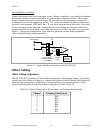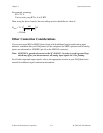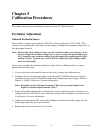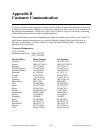Chapter 4 Theory of Operation
© National Instruments Corporation 4-3 SC-2043-SG User Manual
Bridge Completion Network
The SC-2043-SG provides onboard bridge completion that you can use with half-bridge and
quarter-bridge networks.
The SC-2043-SG has a single half-bridge reference that is common to all channels, consisting of
a resistive divider network of two 2.5 kΩ resistors, with 0.02% ratio tolerance and 2 ppm/°C
tracking temperature coefficient (TCR). Each channel has a jumper that configures the channel
for either half-bridge or full-bridge inputs. When configured for half-bridge inputs, the jumper
connects the half-bridge reference output to the negative input of the instrumentation amplifier in
that channel for half-bridge completion. When configured for full-bridge inputs, the jumper
disconnects the half-bridge reference output from the instrumentation amplifier negative input
and connects the negative input to the CHn- screw terminal for full-bridge signal inputs.
Additionally, sockets are provided for eight quarter-bridge completion resistors. When inserted,
the quarter-bridge completion resistors are connected to the positive inputs of the instrumentation
amplifiers and the -EXn terminals, as shown in the block diagram.
Amplification
Each channel of the SC-2043-SG has an instrumentation amplifier with a fixed gain of 10, to
which the bridge output signals are routed. The instrumentation amplifier inputs are protected
from over-voltages up to ±45 V with the SC-2043-SG powered on and ±30 V powered off.
These amplifiers fulfill two purposes on the SC-2043-SG board. First, they convert differential
input signals into single-ended signals referred to the SC-2043-SG AISENSE node for input
common-mode signal rejection. With this conversion, the SC-2043-SG can extract the bridge
input signals from common-mode noise voltages before the DAQ board samples and converts the
signals. Second, the instrumentation amplifiers amplify input signals, resulting in increased
measurement resolution and accuracy.
Note: If you select the SC-2043-SG as an accessory when you configure your DAQ board
using the NI-DAQ software, NI-DAQ compensates for the gain of 10 by automatically
dividing any input channels 0 through 7 by 10 on the DAQ board.
Configure all unused channels for full-bridge connections and short their inputs to
their respective excitation return screw terminals (-EXn). If the inputs are left open-
circuited, the unused channels will saturate, causing the power consumption of the
SC-2043-SG board to increase significantly.
Offset Nulling
The SC-2043-SG has circuitry for offset nulling adjustment of Wheatstone bridges. The nulling
circuitry uses the excitation voltage as a reference and operates with full-bridge, half-bridge and
quarter-bridge strain gauge configurations. Each channel has its own nulling circuit, with a
trimming potentiometer to adjust the nulling voltage level. The nulling circuit of each channel
also has a resistor that sets the nulling range. You can change the nulling range of the offset
nulling circuitry for each channel by replacing its nulling resistor with a resistor of another value.
Therefore, you can mix your ranges to accommodate each channel requirement. The offset
nulling circuitry has the added advantage of nulling the offset voltages of your entire signal path,
including the bridge, the SC-2043-SG channel, and the DAQ board analog input channel.


















